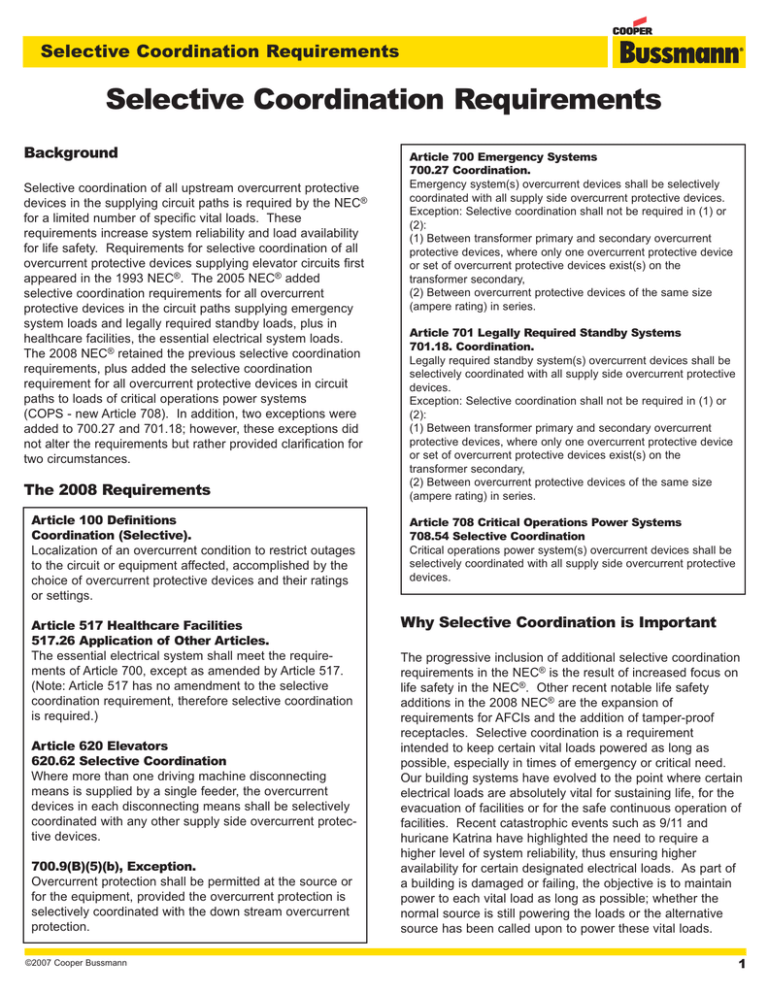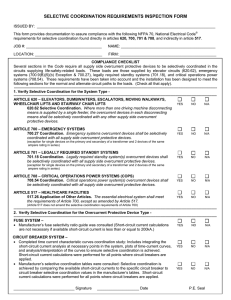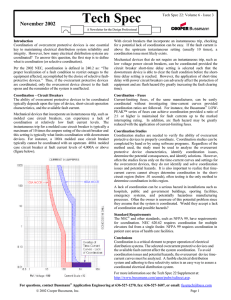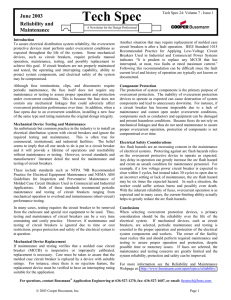Selective Coordination Requirements Background
advertisement

Selective Coordination Requirements Selective Coordination Requirements Background Selective coordination of all upstream overcurrent protective devices in the supplying circuit paths is required by the NEC® for a limited number of specific vital loads. These requirements increase system reliability and load availability for life safety. Requirements for selective coordination of all overcurrent protective devices supplying elevator circuits first appeared in the 1993 NEC®. The 2005 NEC® added selective coordination requirements for all overcurrent protective devices in the circuit paths supplying emergency system loads and legally required standby loads, plus in healthcare facilities, the essential electrical system loads. The 2008 NEC® retained the previous selective coordination requirements, plus added the selective coordination requirement for all overcurrent protective devices in circuit paths to loads of critical operations power systems (COPS - new Article 708). In addition, two exceptions were added to 700.27 and 701.18; however, these exceptions did not alter the requirements but rather provided clarification for two circumstances. The 2008 Requirements Article 100 Definitions Coordination (Selective). Localization of an overcurrent condition to restrict outages to the circuit or equipment affected, accomplished by the choice of overcurrent protective devices and their ratings or settings. Article 517 Healthcare Facilities 517.26 Application of Other Articles. The essential electrical system shall meet the requirements of Article 700, except as amended by Article 517. (Note: Article 517 has no amendment to the selective coordination requirement, therefore selective coordination is required.) Article 620 Elevators 620.62 Selective Coordination Where more than one driving machine disconnecting means is supplied by a single feeder, the overcurrent devices in each disconnecting means shall be selectively coordinated with any other supply side overcurrent protective devices. 700.9(B)(5)(b), Exception. Overcurrent protection shall be permitted at the source or for the equipment, provided the overcurrent protection is selectively coordinated with the down stream overcurrent protection. ©2007 Cooper Bussmann Article 700 Emergency Systems 700.27 Coordination. Emergency system(s) overcurrent devices shall be selectively coordinated with all supply side overcurrent protective devices. Exception: Selective coordination shall not be required in (1) or (2): (1) Between transformer primary and secondary overcurrent protective devices, where only one overcurrent protective device or set of overcurrent protective devices exist(s) on the transformer secondary, (2) Between overcurrent protective devices of the same size (ampere rating) in series. Article 701 Legally Required Standby Systems 701.18. Coordination. Legally required standby system(s) overcurrent devices shall be selectively coordinated with all supply side overcurrent protective devices. Exception: Selective coordination shall not be required in (1) or (2): (1) Between transformer primary and secondary overcurrent protective devices, where only one overcurrent protective device or set of overcurrent protective devices exist(s) on the transformer secondary, (2) Between overcurrent protective devices of the same size (ampere rating) in series. Article 708 Critical Operations Power Systems 708.54 Selective Coordination Critical operations power system(s) overcurrent devices shall be selectively coordinated with all supply side overcurrent protective devices. Why Selective Coordination is Important The progressive inclusion of additional selective coordination requirements in the NEC® is the result of increased focus on life safety in the NEC®. Other recent notable life safety additions in the 2008 NEC® are the expansion of requirements for AFCIs and the addition of tamper-proof receptacles. Selective coordination is a requirement intended to keep certain vital loads powered as long as possible, especially in times of emergency or critical need. Our building systems have evolved to the point where certain electrical loads are absolutely vital for sustaining life, for the evacuation of facilities or for the safe continuous operation of facilities. Recent catastrophic events such as 9/11 and huricane Katrina have highlighted the need to require a higher level of system reliability, thus ensuring higher availability for certain designated electrical loads. As part of a building is damaged or failing, the objective is to maintain power to each vital load as long as possible; whether the normal source is still powering the loads or the alternative source has been called upon to power these vital loads. 1 Selective Coordination Requirements Vital Loads Emergency systems are considered in places of assembly where artificial illumination is required, for areas where panic control is needed such as hotels, theaters, sports arenas, health care facilities, and similar institutions, and where interruption of power to a vital load could cause severe human safety hazards. Emergency loads may include emergency and egress lighting, ventilation and pressurization systems, fire detection and alarm systems, elevators, fire pumps, public safety communications, or industrial process loads where interruption could cause severe human safety hazards. Article 700 provides the requirements. Legally required standby systems are intended to supply power to selected loads in the event of failure of the normal source. Legally required standby systems typically serve loads in heating and refrigeration, communication systems, ventilation and smoke removal systems, sewage disposal, lighting systems, and industrial processes where interruption could cause severe human safety hazards. Article 701 provides the requirements. Where hazardous materials are manufactured, processed, dispensed, or stored, then the loads that may be classified to be supplied by emergency or legally required standby systems include ventilation, treatment systems, temperature control, alarm, detection, or other electrically operated systems Essential electrical systems in healthcare facilities are portions of the electrical system designed to ensure continuity of lighting and power to designated areas/functions during normal source power disruptions or disruptions within the internal wiring system. Essential electrical systems can include the critical branch, life safety branch, and equipment systems which are essential for life safety and orderly cessation of procedures during normal power disruptions. Article 517 provides the requirements and 517.26 refers to Article 700 requirements. vital loads with the goal of safety of human life during emergencies, man made or natural catastrophic events, or loss of the normal power. These articles have numerous requirements that are intended to increase reliability, reduce the probability of faults, and minimize the effects of negative events to the smallest portion of system as possible: all to keep the vital loads up and running as long as possible. Selective coordination of overcurrent devices is another logical requirement that helps ensure a higher system reliability and availability of electrical power to vital loads. The following are examples of a few other Article 700 requirements with similar intent: • 700.4 maintenance and testing requirements • 700.9(B) emergency circuits separated from normal supply circuits • 700.9(C) wiring specifically located to minimize system hazards • 700.16 failure of one component must not result in a condition where a means of egress will be in total darkness What is Selective Coordination Selective coordination can be defined as isolating an overloaded or faulted circuit from the remainder of the electrical system by having only the nearest upstream overcurrent protective device open. Overcurrent protective devices are deemed selectively coordinated only when the nearest upstream overcurrent protective device opens for any possible overcurrents (overload or fault current) that could occur in a specific application. For example, when a fault occurs on a branch circuit, only the branch-circuit fuse or circuit breaker should open. See Figure 1. Similarly, when a fault occurs on a feeder, only the nearest upstream feeder fuse or circuit breaker should open. Selective Coordination Includes the Entire Circuit Path Critical Operations Power Systems (COPS) are systems intended to provide continuity of power to vital operations loads. COPS are intended to be installed in facilities where continuity of operations is important for national security, the economy, or public safety. These systems will be classified COPS by government jurisdiction or facility management. The type of loads may be any and all types considered vital to a facility or organization including data centers and communications centers. New Article 708 provides the requirements. The objective of Article 700, 701, and 708 requirements is to ensure availability and reliability of electrical power to these 2 Figure 1 ©2007 Cooper Bussmann Selective Coordination Requirements The one-line diagrams in Figure 2 and Figure 3 demonstrate the concept of selective coordination. Figure 2 illustrates the circuit path for emergency loads powered by the normal power source and Figure 3 illustrates the circuit path for emergency loads powered by the alternate source. If overcurrent protective devices in circuit paths supplying emergency loads are not selectively coordinated, a fault at X1 on the branch circuit may unnecessarily open the sub-feeder; or even worse the feeder or possibly even the main. In this case, emergency loads are unnecessarily blacked out. With selective coordination as a requirement for emergency, legally required standby, and essential electrical loads, when a fault occurs at X1 only the nearest upstream fuse or circuit breaker supplying just that circuit would open. Other emergency loads would remain powered. The same analysis can be made for faults occurring at the feeder level. Normal Path and Alternate Path For these vital loads, selective coordination is required for both the normal power circuit path and the alternate power circuit path. The requirements state selective coordination is required, “with all supply side overcurrent protective devices”. Selective coordination is about the continuance of power to vital loads. These vital loads in the emergency systems, legally required standby systems, critical operations power systems, and essential electrical systems can be powered through the normal source or through the alternate source. The overcurrent protective devices must be selectively coordinated from each load branch circuit up through both the normal source main and alternative source. Code Panels 12, 13, and 20 carefully chose their words with all supply side overcurrent devices for this requirement, because they wanted to assure that these vital loads are not disrupted, whether fed from the normal source or the alternate source. There are several reasons for this. If the overcurrent protective devices are not selectively coordinated in the normal path to the vital loads, a fault can cause the OCPDs to cascade thereby unnecessarily opening the feeder on the loadside of the transfer switch as well as the feeder and service on the lineside of transfer switch. This action reduces the reliability of the system since there is some probability that the generator may not start or the transfer switch may not transfer. In addition, when the generator starts and the loads transferred to the alternate source, some vital loads will be unnecessary blacked out due to the feeder OCPD’s lack of selective coordination (it is still open unnecessarily). In assessing whether the overcurrent protective devices are selectively coordinated in the circuit path for these vital loads, it is important that the available short-circuit current from the normal source be considered since it may cause fault currents much higher than from the alternate source. ©2007 Cooper Bussmann Full Range of Overcurrents To comply, the overcurrent protective devices must selectively coordinate for the full range of overcurrents possible for the application. It is not selective coordination if the fuses or circuit breakers are coordinated only for overloads and low level fault currents. The fuses or circuit breakers must also be selectively coordinated for the maximum short-circuit current available at each point of application. In a Panel Statement during the 2008 ROP cycle, Code Panel 13 responded to a proposal to alter the selective coordination requirement: “…the instantaneous portion of the time current curve is no less important than the long time portion.” Higher level faults may not occur as frequently as lower level faults, but they can and do occur. Higher level faults will be more likely during fires, attacks on buildings, or building failures or more likely as the system ages, or if proper maintenance is not performed regularly. Also, all too often, the circuits for these vital loads may be worked on while energized and a worker-caused fault can be of a significant fault level Selective coordination has a very clear and unambiguous definition. Either overcurrent protective devices in a circuit path are selectively coordinated for the full range of over currents for the application or they are not. The words “optimized selective coordination”, “selectively coordinated for times greater than 0.1 seconds”, or other similar wording are merely attempts to not meet the selective coordination requirements. And terms like “selective coordination where practicable” is unenforceable. Code Panels 12, 13, and 20 have discussed and declined any wording that lessens the requirement from the full range of overcurrents or lessens the enforceability. Faster Restoration & Increased Safety Besides minimizing an outage to only the part of the circuit path that needs to be removed due to an overcurrent condition, selective coordination also ensures faster restoration of power when only the closest upstream overcurrent protective device opens on an overcurrent. When the electrician arrives to investigate the cause, correct the cause, ensure the integrity of the circuit components for re-energization, and restore power, the electrician does not have to spend time locating upstream overcurrent protective devices that unnecessarily opened. This also increases safety by avoiding unneccessary reclosing or replacing OCPDs. 3 Selective Coordination Requirements Figure 2 - Emergency loads powered by normal source Figure 3 - Emergency loads powered by alternative source Ensuring Compliance Achieving the proper overcurrent protective device selective coordination requires proper engineering, specification and installation of the required overcurrent protective devices. It is possible for both fusible or circuit breaker systems to be selectively coordinated with proper analysis and selection. See the section Achieving Selective Coordination. Authority Having Jurisdiction (AHJ): the AHJ does not have to be an expert at overcurrent device coordination to enforce the selective coordination requirements. It is a simple matter of requiring a professional engineer to provide his or her seal on documentation that states selective coordination is achieved. The documentation should include a selective coordination analysis and the specified 4 overcurrent devices with pertinent information on type, ampere ratings, and options/settings, if appropriate. During site inspection, the AHJ may choose to spot check the installation to see if the installation is as specified. It is advisable for the jurisdiction to proactively let the electrical community know that the requirements are being enforced. If the contractor installs a non-selectively coordinated system that gets red tagged, the cost and time to correct the system are often substantial. Engineers: Selective coordination is best resolved in the design phase. Depending on the load needs and types of overcurrent protective devices, engineers have flexibility. It is the engineer’s responsibility to provide documentation that verifies the overcurrent devices are selectively coordinated for the full range of overcurrents that can occur in the system. ©2007 Cooper Bussmann Achieving Selective Coordination If fuses are used, a circuit schedule with Cooper Bussmann fuse types and ampere ratings adhering to the Cooper Bussmann fuse selectivity ratios is the easiest verification analysis method. The selectivity ratios are valid for all overcurrent conditions up to the interrupting rating of the fuses. If circuit breakers are used, it is necessary to do a shortcircuit current study, plot the time-current characteristic curves, and interpret the data properly. In some cases, circuit breaker manufacturers publish tables showing at what values of short-circuit current their circuit breakers coordinate. A schedule is needed that shows the circuit breaker types, options, settings, and available short-circuit currents. The schedule should reference the corresponding time-current curve with interpretation analysis or the manufacturer’s coordination tables showing how the circuit breakers are selectively coordinated for the full range of overcurrents. If alternatives are submitted, the same documentation as above should also be submitted so that the engineer can assess that selective coordination is achieved. Installer: the contractor should install per the engineer’s specifications or approved submittals. If the system is circuit breakers, the installer must ensure the circuit breaker settings (short-time delay and instantaneous trip) are set per the engineer’s coordination analysis. Circuit breakers are shipped from the manufacturers with the short-time delay and instantaneous trip settings on low or the minimum; these settings may require adjustment. Achieving Selective Coordination Following is a brief overview of achieving selective coordination with fuses or circuit breakers. For more in-depth discussion, visit www.cooperbussmann.com or call application engineering at 636-527-1270. At the time of this publication, materials are being developed, so please check periodically, if interested in a more in-depth discussion. Also, publication SPD – Selecting Protective Devices, Based on the 2005 NEC has a more in-depth discussion. The 2008 NEC version of the SPD publication will be updated with more selective coordination information and is planned to be available in early 2008. Fuse Systems Cooper Bussmann makes it easy to design and install fusible systems that are selectively coordinated. For modern currentlimiting, low voltage fuses, selectivity ratios are published. Figure 4 illustrates a Fuse Selectivity Ratio Table for the fuses in the example. It is not necessary to plot time current curves or do a short-circuit current analysis; all that is necessary is to make sure the fuse types and ampere rating ratios for the mains, feeders and branch circuits meet or ©2007 Cooper Bussmann exceed the selectivity ratios. If the ratios are not satisfied, then the designer should investigate another fuse type or design change. These selectivity ratios are for all levels of overcurrent up to the interrupting ratings of the respective fuses. The ratios are valid even for fuse opening times less than 0.01 seconds. This means with current-limiting fuses, it is not necessary to do any analysis for less than 0.01 seconds when the fuse types and ampere rating ratios adhere to the selectivity ratios. The installer just needs to install the proper fuse type and ampere rating. There are no settings to adjust. The following example illustrates all that is necessary to achieve selective coordination with a fusible system. Figure 4 - Using the Fuse Selectivity Ampere Rating Ratios In order to provide a selectively coordinated fusible system, fusible branch circuit lighting panels may be needed. To fulfill this need, Cooper Bussmann has the Coordination Module, a fusible branch circuit lighting panel. The Product Profile #3115 is located at www.CooperBussmann.com under product literature - sales literature. The coordination module branch circuits incorporate Class CC fuses (LP-CC) for branch circuit protection. Fuseholders with easyID Neon Indicator provide open fuse indication. Class CC fuses are available from 1/10 to 30A. 1 1⁄2 inch LP-CC Fuse Cooper Bussmann® Coordination Module 5 Achieving Selective Coordination Circuit Breaker Systems Systems can be designed with circuit breakers where selective coordination can be achieved. It is important that the curves and circuit breaker functionality are interpreted properly by a qualified person. Typically the steps necessary are: 1. Short-circuit current calculation study: Determine the available short-circuit current (both normal source and alternate source) at every point of application in order to select the proper interrupting rated circuit breakers and to interpret the curves as to whether a circuit breaker scheme is selectively coordinated for the specific application. 2. Time current characteristic analysis: Plot the curves for the circuit breakers of each circuit path, note the available short-circuit currents, and determine if the circuit breakers for that circuit path are selectively coordinated. If not, then, 3. Trial and error method: try various setting adjustments, CB types, options, or design change. Figure 5 illustrates a circuit breaker system where the 20A branch circuit breaker is selectively coordinated with the 100A feeder circuit breaker as long as the available short circuit current at the branch panel does not exceed 900A. Also, this figure illustrates the 100A feeder circuit breaker is selectively coordinated with the 800A main circuit breaker, which has a short-time delay. Figure 6 illustrates a system where the 20A, 100A and 800A circuit breakers are selectively coordinated for all levels of available short-circuit current up to their respective interrupting ratings. This is achieved by using feeder and main circuit breakers with short-time delays (without any instantaneous override feature). Figure 5 6 Figure 6 Circuit Breaker Selective Coordination Alternatives 1.MCCBs, ICCB,s and LVPCBs with instantaneous trip settings 2.MCCBs with fixed high magnetic trip or larger frame size may allow higher instantaneous trip 3.CBs coordinated to manufacturer’s tested coordination tables • CB manufacturers have coordination testing on many MCCBs • These tables can enable circuit breakers to coordinate for fault currents higher than shown on the time current curves 4.CBs with short time delay having instantaneous trip override • MCCBs and ICCBs with short-time delay settings, typically have an instantaneous trip override that opens the CB instantaneously for higher fault currents (10X to12X amp rating) • ICCBs and some LVPCBs may have higher instantaneous override settings than MCCBs 5.ICCBs and LVPCBs with short time delay (with no instantaneous override): allow sufficient separation between time current bands Notes: • The instantaneous trip of upstream circuit breakers must be greater than the available short-circuit current for alternatives 1, 2, and 4 • Interpret the time current curves properly • Some options may require larger frame size or different type CBs • Maintenance and testing should be performed periodi cally or after fault interruption to retain proper clearing times and the coordination scheme ©2007 Cooper Bussmann




